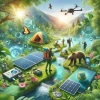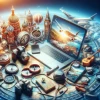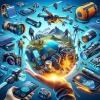
In today's fast-paced world, planning a trip can feel like a daunting task. Yet, with the advent of technology, creating a travel itinerary that is both memorable and efficient has become more accessible than ever. This article delves into how you can leverage various technological tools to design an itinerary that not only meets your expectations but exceeds them, ensuring a journey filled with discovery and joy.
The Role of Technology in Modern Travel
Gone are the days when travel planning involved flipping through bulky guidebooks and scribbling notes on paper maps. Today, technology has revolutionized the way we plan our adventures. With a smartphone in hand, travelers can access a plethora of apps and websites that offer everything from flight bookings to restaurant recommendations. This digital shift has made information more accessible, allowing travelers to make informed decisions and tailor their experiences to their preferences.
Choosing the Right Tools for Your Itinerary
The first step in crafting a remarkable itinerary is selecting the right tools. Apps like Google Maps and Rome2Rio can help you navigate unfamiliar territories with ease, while platforms like TripIt and Kayak consolidate your travel details in one place. A common mistake is to rely on a single app for all your needs. Instead, use a combination of tools to cover different aspects of your journey, ensuring you don't miss out on any crucial details.
Personalizing Your Travel Experience
One of the greatest advantages of using technology is the ability to personalize your travel experience. Platforms like Airbnb and EatWith connect you with local hosts, offering unique insights and experiences that traditional hotels and restaurants may not provide. Additionally, apps like Culture Trip offer curated guides based on your interests, whether it's art, history, or cuisine. Remember, the key to a memorable trip is not just seeing the sights, but engaging with the culture and people.
Avoiding Common Pitfalls
While technology is a powerful ally in travel planning, it's not without its pitfalls. One common mistake is over-reliance on digital maps, which can lead to missing out on spontaneous discoveries. Another is ignoring offline access. Always download maps and important information before your trip, as connectivity issues can arise unexpectedly. Lastly, be wary of over-scheduling; leave room for flexibility and serendipity.
Staying Safe and Secure
Safety should always be a priority when traveling. Use apps like Google Translate to communicate in local languages, and ensure your devices are equipped with security software to protect against cyber threats. Additionally, platforms like Smart Traveler Enrollment Program (STEP) offer travelers updates on safety conditions in their destination. By staying informed and prepared, you can enjoy your travels with peace of mind.
Maximizing the Use of Social Media
Social media platforms such as Instagram and Pinterest are not just for sharing your travel photos. They are treasure troves of travel inspiration and tips. Follow travel influencers and hashtags to discover hidden gems and get firsthand reviews. However, be cautious of overly curated content that may not reflect reality. Balance social media insights with information from reliable travel sites and locals.
The Future of Travel Planning
As technology continues to evolve, so too will the tools available for travel planning. Artificial intelligence and augmented reality are already making their mark, offering personalized recommendations and immersive experiences. Keep an eye on emerging technologies and be open to adopting new tools that can enhance your travel experience. The future promises even more innovative ways to explore the world.



























